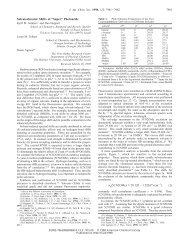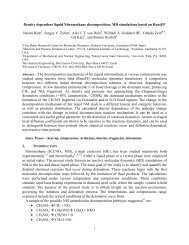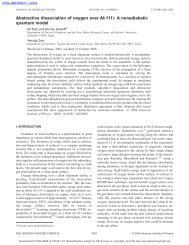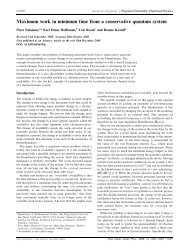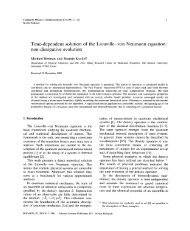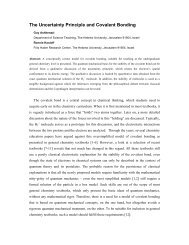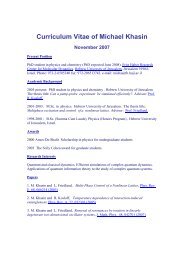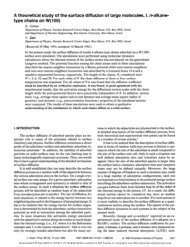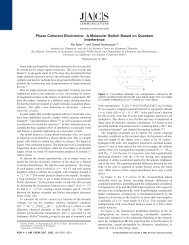Molecular Symmetry Properties of Conical Intersections and ...
Molecular Symmetry Properties of Conical Intersections and ...
Molecular Symmetry Properties of Conical Intersections and ...
You also want an ePaper? Increase the reach of your titles
YUMPU automatically turns print PDFs into web optimized ePapers that Google loves.
2992 J. Phys. Chem. A, Vol. 114, No. 9, 2010 Al-Jabour et al.<br />
(i) the assignment <strong>of</strong> the molecular symmetry (MS) <strong>of</strong> the<br />
given system which may undergo large amplitude motion, e.g.,<br />
torsion, cf. ref 8, <strong>and</strong> considerations <strong>of</strong> the consequences, e.g.,<br />
applications <strong>of</strong> the molecular symmetry operations in order to<br />
construct sets <strong>of</strong> analogous symmetry-related geometries, <strong>and</strong><br />
a discussion <strong>of</strong> the difficulties to assign molecular IREPs to<br />
electronic states,<br />
(ii) the definition <strong>of</strong> corresponding symmetry-adapted nuclear<br />
coordinates <strong>and</strong> their derivatives which should transform as the<br />
IREPs <strong>of</strong> the MS group, for small as well as large amplitude<br />
motions,<br />
(iii) the expression <strong>of</strong> the CIs <strong>and</strong> the corresponding seams 2<br />
<strong>of</strong> the CIs in terms <strong>of</strong> these coordinates,<br />
(iv) the definition <strong>of</strong> the related NACTs using the symmetryadapted<br />
coordinates,<br />
(v) the derivation <strong>of</strong> two theorems which relate the IREPs <strong>of</strong><br />
different NACTs to each other,<br />
(vi) the determination <strong>of</strong> symmetric nodes <strong>of</strong> the NACTs,<br />
together with the (relative) signs <strong>of</strong> the NACTS in different<br />
symmetry-related domains, even far away from the CIs,<br />
(vii) the assignment <strong>of</strong> IREPs to the NACTs, by means <strong>of</strong><br />
the two general theorems as well as by three well-known<br />
properties <strong>of</strong> the NACTs related to the CIs. Specifically, we<br />
shall employ the so-called quantization rule for the NACTs, 1<br />
the pole property <strong>of</strong> the NACTs close to the CIs, 1,2 <strong>and</strong> the fact<br />
that the electronic wave functions for the two states which<br />
become degenerate at a CI may change characters close to the<br />
CIs, with consequences for the NACTs. Further details will be<br />
specified below; see eqs 22-27 in section II. Here, it is sufficient<br />
to say that these properties have been documented previously,<br />
mainly for small molecules, i.e., tri- <strong>and</strong> tetra-atomic molecules,<br />
without considerations <strong>of</strong> large amplitude motions which call<br />
for molecular symmetry groups. 1,2,9-27 An approach based on<br />
an ab initio treatment 1,28,29 was recently extended to a larger<br />
system, CH3NH2. 30<br />
(viii) the definition <strong>of</strong> corresponding signs or “charges” <strong>of</strong><br />
the symmetry-related CIs,<br />
(ix) the assignment <strong>of</strong> the corresponding IREPs <strong>of</strong> the CIs,<br />
(x) the derivation <strong>of</strong> different topologies <strong>of</strong> the seams <strong>of</strong> the<br />
CIs depending on their molecular symmetries in a specific plane<br />
<strong>of</strong> MS-adapted coordinates.<br />
While this work plan (i-x) should be applicable to arbitrary<br />
molecules which undergo small as well as large amplitude<br />
motions which transform according to 1-d IREPs <strong>of</strong> the MS<br />
group, they will be explained <strong>and</strong> demonstrated for a specific<br />
example, i.e., cyclopenta-2,4-dienimine (C5H4NH). For example,<br />
in step i, we shall determine its molecular symmetry group, etc.<br />
This allows us to illustrate a number <strong>of</strong> additional consequences<br />
<strong>of</strong> the MS for the NACTs <strong>and</strong> CIs including<br />
(xi) the support <strong>of</strong> quantum chemistry calculations <strong>of</strong> the<br />
NACTs in domains far away from the CIs <strong>and</strong>, last but not<br />
least,<br />
(xii) tests <strong>of</strong> self-consistency; e.g., the symmetry-adapted<br />
NACTs satisfy quantization rules which have been derived<br />
previously by one <strong>of</strong> us. 1<br />
The chosen model system C5H4NH is challenging because it<br />
is a rather large (compared to the above-mentioned models)<br />
exocyclic analogue <strong>of</strong> methylene-imine (CH2NH), the parent<br />
molecule with a CdN double bond, which provides two<br />
different reaction pathways from the planar syn configuration<br />
<strong>of</strong> the reactant along large amplitude motions via three different<br />
transition states to the planar anti configurations <strong>of</strong> the product, 31<br />
pointing to possibly rich <strong>and</strong> instructive scenarios <strong>of</strong> various<br />
conical intersections. For the purpose <strong>of</strong> a pro<strong>of</strong> <strong>of</strong> principle,<br />
the present investigation <strong>of</strong> the symmetry properties <strong>of</strong> C5H4NH<br />
will be restricted to just three electronic states: first, the<br />
electronic ground state S0 which has a potential minimum for<br />
the planar syn configuration. At this special configuration,<br />
traditional quantum chemistry assigns the notation S0 ) 1A′,<br />
according to the “local” IREP A′ <strong>of</strong> the corresponding molecular<br />
point group Cs (NOT to be mixed up with global molecular<br />
symmetry.) Moreover, we include the next two excited singlet<br />
states which have (local) A′ symmetry, S1 ) 2A′ <strong>and</strong> S2 ) 3A′.<br />
Since we aim at describing large amplitude motions, i.e., torsion,<br />
we shall not employ the notation for the “local” symmetry.<br />
Instead, we shall use the “global” notation Sj, with j ) 0, 1,<br />
<strong>and</strong> 2 which indicates the energetic order <strong>of</strong> the adiabatic<br />
potentials Vj.<br />
The double goal <strong>of</strong> the general derivations <strong>and</strong> the verifications<br />
by means <strong>of</strong> quantum chemistry calculations for the model<br />
system C5H4NH should provide significant extensions <strong>of</strong> the<br />
theory for the NACTs <strong>and</strong> CIs, beyond the quoted previous<br />
investigations. The work plan (i-x) will be carried out in section<br />
II. The results will be confirmed by quantum chemical calculations,<br />
starting from the location <strong>of</strong> a conical intersection <strong>of</strong> state<br />
S0 <strong>and</strong> S1 based on the Longuet-Higgins phase change theorem; 32,33<br />
see also refs 34-36 until items xi <strong>and</strong> xii; see section III. The<br />
conclusions are in section IV.<br />
II. Theory with an Example<br />
A. Assignment <strong>of</strong> the <strong>Molecular</strong> <strong>Symmetry</strong> Group. According<br />
to the work-plan <strong>of</strong> section I, our derivation starts with<br />
(i) the assignment <strong>of</strong> the molecular symmetry group <strong>of</strong> the<br />
given system, allowing large amplitude motion, e.g., torsion,<br />
cf. ref 8, focusing on groups with 1-d IREPs. The group MS<br />
consists, in general, <strong>of</strong> G symmetry operations Sˆ g, with g ) 1,<br />
2, ... , G, including the identity Sˆ 1 ) E, all feasible permutations<br />
P <strong>of</strong> the spatial <strong>and</strong> spin coordinates <strong>of</strong> equivalent nuclei, <strong>and</strong><br />
possibly the inversion E* <strong>of</strong> all nuclear coordinates s <strong>and</strong><br />
electronic coordinates se, <strong>and</strong> the inversion-permutations PoE*;<br />
specific choices <strong>of</strong> symmetry-adapted coordinates will be made<br />
below; see item ii. Application <strong>of</strong> the symmetry operations to<br />
a specific set <strong>of</strong> values (written with square brackets), say, s, se<br />
) [s, se]1, generates a set <strong>of</strong> other values <strong>of</strong> the coordinates<br />
[s, s e ] g ) Sˆ g [s, s e ] 1 with g ) 1, 2, ... , G (1)<br />
These will be called “symmetry-related” (sets <strong>of</strong> values <strong>of</strong>)<br />
coordinates. They may be far away from each other. Nevertheless,<br />
the large amplitude motions may provide feasible paths<br />
from nuclear coordinates [s]1 to the symmetry-related ones [s]g.<br />
Accordingly, the molecular symmetry group possesses G<br />
IREPs denoted as Γg, with g ) 1, ... , G, say, Γ1 ) A1, Γ2 ) A2,<br />
Γ3 ) B1, etc., with associated characters g,h <strong>and</strong> symmetry<br />
projection operators Pˆ Γ g. For 1-d IREPs,<br />
Pˆ Γg ) 1<br />
G ∑ h<br />
g,h Sˆ h<br />
These Pˆ Γ g commute with each other, <strong>and</strong> with the total<br />
Hamiltonian H ) Tnu + Hel <strong>of</strong> the system, where Tnu is the<br />
nuclear kinetic energy operator <strong>and</strong> Hel is the electronic<br />
Hamiltonian. Moreover, they commute also with Hel. Asa<br />
consequence, the (real-valued) electronic eigenfunctions<br />
ψj(se; s) <strong>of</strong>Hel<br />
(2)



